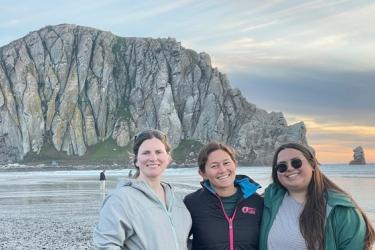Currently aboard the NOAA FSV Bell M. Shimada, we are collecting plankton tow samples to assess the community of foraminifera ('forams', for short), a calcifying marine plankton that is ubiquitous in the ocean, across the Northern California Current, sampling within and outside of the current warm water anomaly (>16°C.).
A few years ago, the 2014-2016 'Warm Blob' in the Pacific had profound effect on marine life, but the effect the Warm Blob had on foraminifera has not yet been investigated. Kelsey, an OSU Marine Resources Management grad student, has been investigating how the foraminifera assemblage changed during the previous marine heat wave by looking through historical samples collected along the Newport Hydrographic Line. Preliminary data shows that during the Warm Blob, warmer water foram species are found. During the peak warming in 2015, tropical species became abundant. For example, a species that is quite rare to this region, G. ruber, was abundant in the plankton tows that span the entire NH line with the greatest abundance in the samples collected 200 miles offshore.

The 1 meter, 150um mesh net used to capture foraminifera. Photo: NOAA Fisheries
 The warmer water assemblage of foraminifera. O. universa and N. dutertrei are common. Photo: NOAA Fisheries
The warmer water assemblage of foraminifera. O. universa and N. dutertrei are common. Photo: NOAA Fisheries
During this cruise we started sampling on the Newport Hydrographic Line where we found that the most abundant forams in our net tows were subtropical species that are less common to this region. As we transitioned south into cooler waters near Coos Bay, the assemblage returned to species more typically found in the colder waters offshore Oregon.
Upon returning north, we found that again, subtropical species were common in our samples.
 The colder water assemblage of foraminifera. T. quinqueloba, N. incompta and G. falconensis are common. Photo: NOAA Fisheries
The colder water assemblage of foraminifera. T. quinqueloba, N. incompta and G. falconensis are common. Photo: NOAA Fisheries
 An N. dutertrei that has recovered from collection and doing well in culture. Photo: NOAA Fisheries
An N. dutertrei that has recovered from collection and doing well in culture. Photo: NOAA Fisheries
 A comparison of the size of the planktic forams. Much larger, subtropical species (lower slide) dominate in the warmer water compared to the smaller species (upper slide) in the colder water mass. Photo: NOAA Fisheries
A comparison of the size of the planktic forams. Much larger, subtropical species (lower slide) dominate in the warmer water compared to the smaller species (upper slide) in the colder water mass. Photo: NOAA Fisheries
We are also keeping some foraminifera alive in culture on the ship and they're doing well, happily growing and even reaching the end of their life cycle and producing gametes!
The next stations we plan to sample are further north and within the warm water, so we'll keep you updated on what we find.

